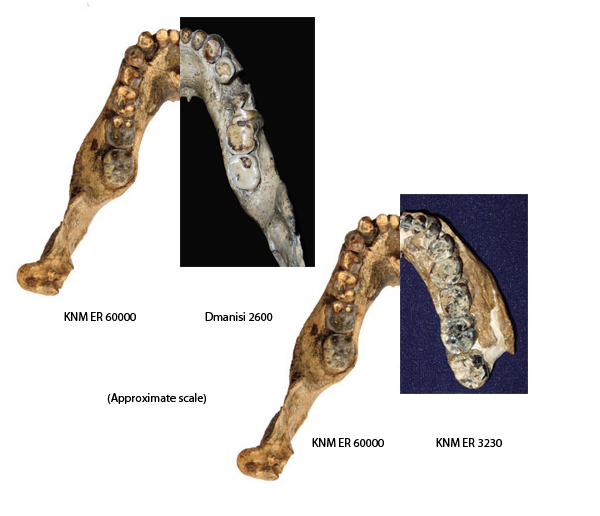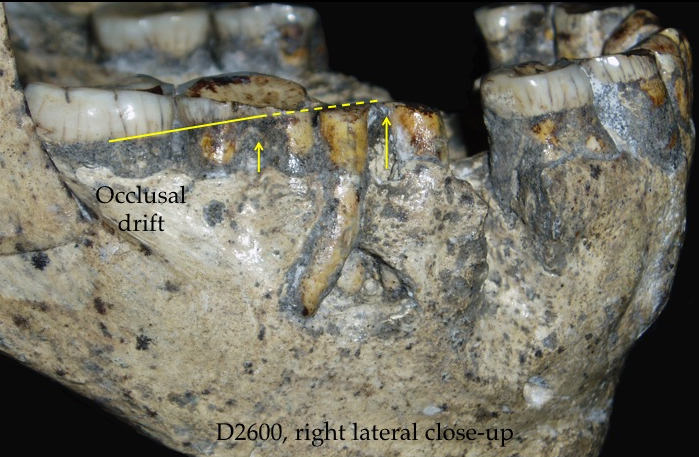My latest paper examining metric variation in the Lower Paleolithic Dmanisi mandibular sample, co-authored with David Lordkipanidze, is available today via Paleoanthropology’s website (open access).
Synopsis: The Dmanisi mandibular sample is a well-preserved, age-stratified set of remains, that poses interesting questions for interpreting metric variability at the site. In particular, the large D2600 mandible creates a particularly striking set of morphological size differences between this specimen and the two smaller, late adolescent specimens, D211 and D2735. These differences have been interpreted by some researchers as evidence for at least two, conspecific species of early Homo at the locality. We disagree with this hypothesis and suggest it is wrong for a number of reasons. First, nothing about the stratigraphy or geological setting of the remains provides support for separate taxa. The D2600 mandible is found in the same deposits, literally a few feet away (even less in some cases) from remains associated with the other mandibular remains. Second, there are a number of interesting synapomorphic features shared across the sample. And finally, while there are individual metric comparisons that fall outside the range of expected variation (based on recent human, Pan, Gorilla comparisons). the strength of these differences in a phylogenetic argument is undercut by the other similarities and small sample size of the sample. So, we conclude, supporting a lot of other research on other aspects of the Dmanisi sample, that it likely samples a single taxon of early Homo.
A couple of points to add to the publication itself. First, as I previously pointed out, the KNM ER-60000 specimen that was recently published by Leakey et al. (2012) is the best single mandibular match in metric proportions to D2600. This similarity in size, previously lacking in the early Homo record, is encouraging, and points to the potential size continuity between the large Dmanisi specimen and earlier East African material.

Measurement D 2600 ER 60000 Symphysis Height 50 43 Corpus height at P4 42 39 Corpus height at M1 41 38 Corpus breadth at M1 21 20 Corpus height at M2 37 35 Corpus breadth at M2 22 21 P3-P4 alveolar length 19 16 M1-M3 alveolar length 45 43 Condylar height 83 89 * Data from Leakey et al. 2012, supplementary information
The presence of this specimen makes the large Dmanisi mandible less of an outlier.
Secondly, there is still an interesting story to be told in the specific anatomical details of the large Dmanisi mandible. Ani Margvelashvili has presented some of her own excellent work on the topic at conferences the past several years. In short, though, I think it is necessary to acknowledge the tremendous dental wear and attrition in the D2600 specimen to fully appreciate the metric dimensions of the specimen. In particular, the relationship between the tremendous occlusal drift of the dentition in D2600, related alveolar/mandibular pathologies and the overall height of the corpus is worth further exploration.
All of which is to say, it is an interesting set of fossils and the assemblage as a whole still has a lot to say about human evolution in the early Pleistocene.
*****
1. Meave G. Leakey, Fred Spoor, M. Christopher Dean, Craig S. Feibel, Susan C. Antón, Christopher Kiarie & Louise N. Leakey. New fossils from Koobi Fora in northern Kenya confirm taxonomic diversity in early Homo. Nature 488, 201–204 (09 August 2012) doi:10.1038/nature11322
2. Adam P. Van Arsdale and David Lordkipanidze (2012) “A Quantitative Assessment of Mandibular Variation in the Dmanisi Hominins.” PaleoAnthropology 2012:134-144. ISSN:1545-0031

